Page 48 of 340
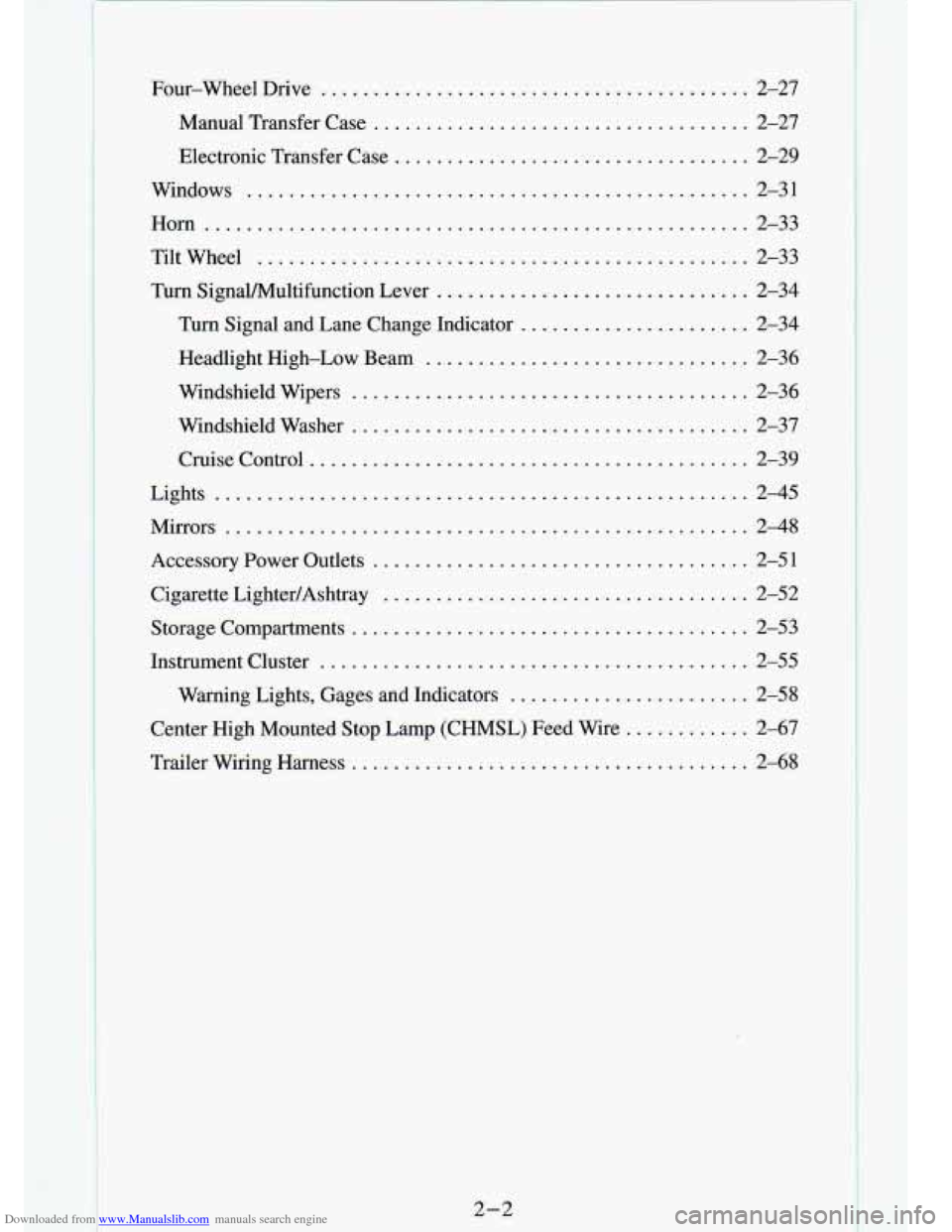
Downloaded from www.Manualslib.com manuals search engine ...
.
Four-wheel Drive ......................................... 2-27
Manual Transfer Case
.................................... 2-27
Electronic Transfer Case
.................................. 2-29
Windows
................................................ 2-31
Horn
.................................................... 2-33
TiltWheel
............................................... 2-33
Turn SignaYMultifunction Lever
.............................. 2-34
Turn Signal and Lane Change Indicator
...................... 2-34
Headlight High-Low Beam
............................... 2-36
Windshield Wipers
...................................... 2-36
Windshield Washer
...................................... 2-37
Cruise Control
.......................................... 2-39
Lights
................................................... 2-45
Mirrors
.................................................. 2-48
Accessory Power Outlets
.................................... 2-51
Cigarette LightedAshtray ................................... 2-52
Storage Compartments ...................................... 2-53
Instrument Cluster
......................................... 2-55
Wamrng Lights, Gages and Indicators
....................... 2-58
Center High Mounted Stop Lamp (CHMSL) Feed Wire
............ 2-67
Trailer Wiring Harness
...................................... 2-68
2-2
Page 54 of 340
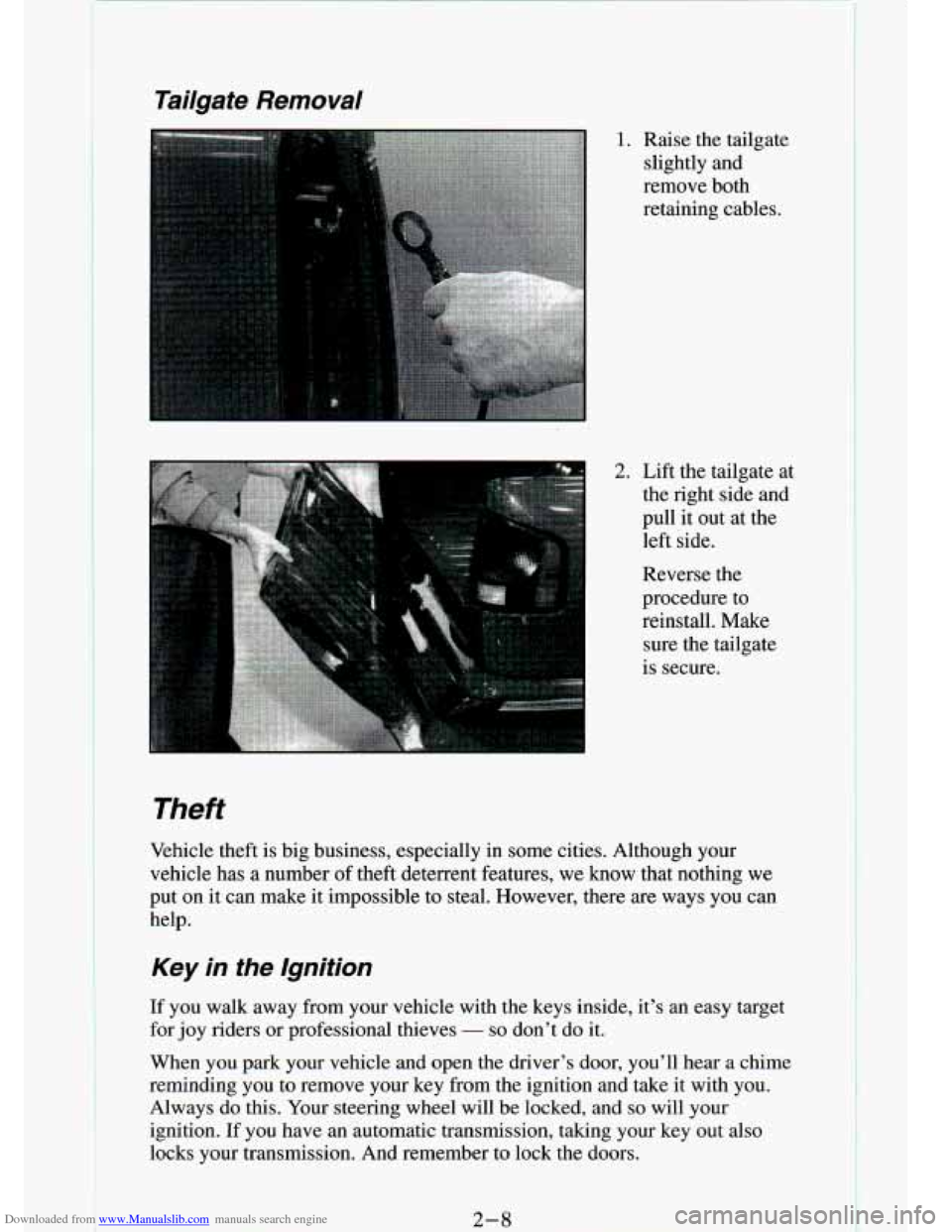
Downloaded from www.Manualslib.com manuals search engine Tailgate Removal
Theft
1.
2.
Raise the tailgate slightly and
remove both
retaining cables.
Lift the tailgate at the right side and
pull
it out at the
left side.
Reverse the
procedure to
reinstall. Make sure the tailgate
is secure.
Vehicle theft is big business, especially in some cities. Altho\
ugh your vehicle has
a number of theft deterrent features, we know that nothing we
put on it can make it impossible to steal. However, there are ways you can
help.
Key in the Ignition
If you walk away from your vehicle with the keys inside, it’s an easy target
for joy riders or professional thieves
- so don’t do it.
When you park your vehicle and open the driver’s door, you’\
ll hear a chime
reminding you to remove your key from the ignition and take i\
t with you.
Always do this. Your steering wheel will be locked, and
so will your
ignition.
If you have an automatic transmission, taking your key out also
locks your transmission. And remember to lock the doors.
2-8
Page 56 of 340
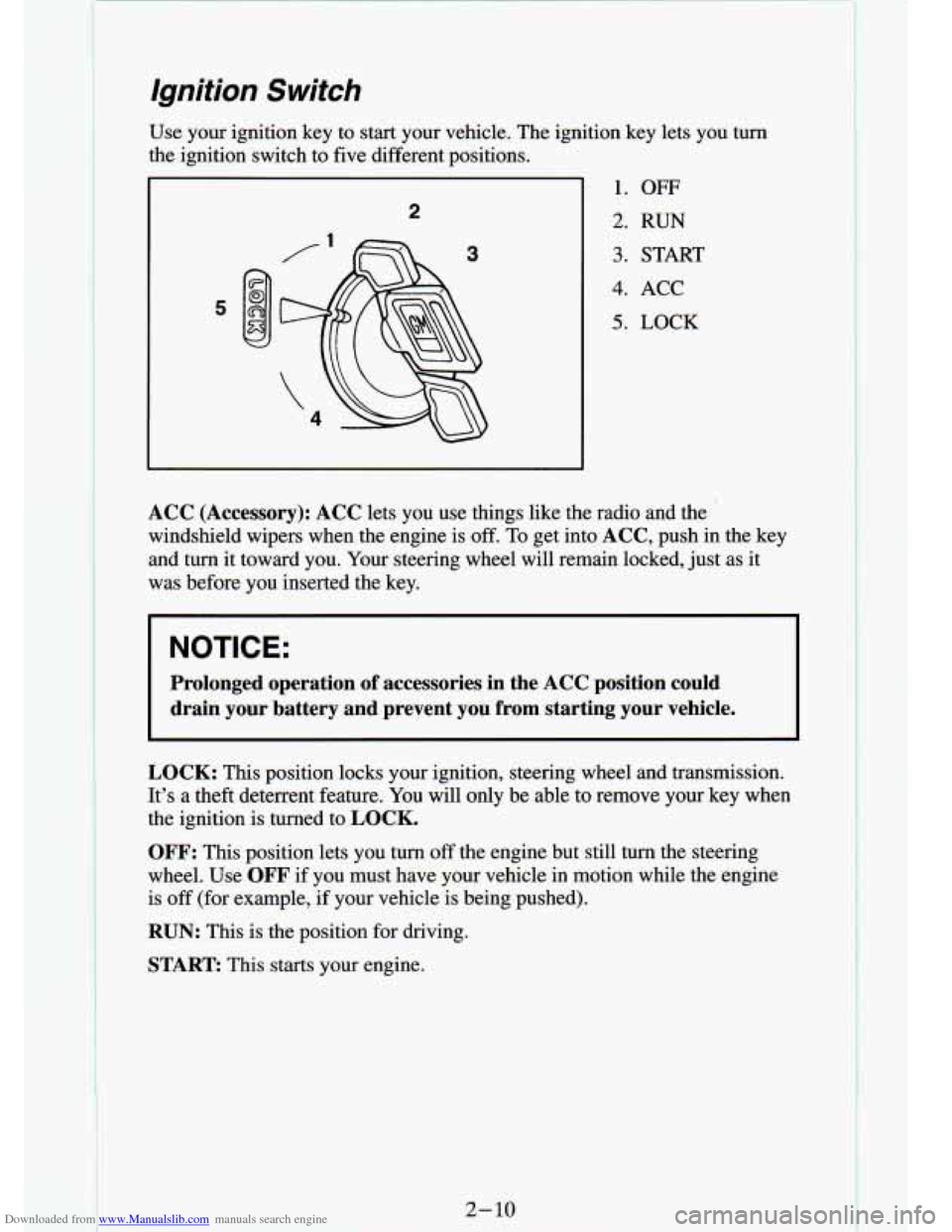
Downloaded from www.Manualslib.com manuals search engine Ignition Switch
Use your ignition key to start your vehicle. The ignition key \
lets you turn
the ignition switch to five different positions.
2
3
1. OFF
2. RUN
3. START
4. ACC
5. LOCK
ACC (Accessory): ACC lets you use things like the radio and the
windshield wipers when the engine is
off. To get into ACC, push in the key
and turn it toward you. Your steering wheel will remain locked, just as it
was before you inserted the key.
NOTICE:
Prolonged operation of accessories in the ACC position could
drain vour battery and prevent you
from starting your vehicle.
LOCK: This position locks your ignition, steering wheel and transmissi\
on.
It’s a theft deterrent feature. You will only be able to remove your key when
the ignition is turned to
LOCK.
OFF: This position lets you turn off the engine but still turn the steering
wheel. Use
OFF if you must have your vehicle in motion while the engine
is off (for example,
if your vehicle is being pushed).
RUN: This is the position for driving.
START: This starts your engine.
Page 57 of 340
Downloaded from www.Manualslib.com manuals search engine NOTICE:
If your key seems stuck in “Lockyy and you can’t turn it, be sure
it is all the
way in. If it is, then turn the steering wheel Ieft and
right while you turn the key hard. But turn the key only with
your hand. Using a tool to force it could break the key or the
ignition switch.
If none of this works, then your vehide needs
service.
Key Release Lever
The ignition key
cannot be removed
from the ignition of
manual transmission
vehwles unless the
key release lever is
used.
To Remove the Key
Turn the key to the LOCK position while pressing the key release lever
down at the same time. Keeping your finger on the lever, pull the key
On automatic transmission vehicles, turn the key to LOCK and pull it
straight out.
straight out.
2- 11
Page 62 of 340
Downloaded from www.Manualslib.com manuals search engine How long should you keep the coolant heater plugged in? The answer
depends on the weather, the kind
of oil you have, and some other things.
Instead of trying to list everything here, we ask that you contact a GM
dealer in the area where you’ll be parking your vehicle. The dealer can give
you the best advice for that particular area.
Automatic Transmission
I There are several
different positions for
your shift lever.
P (Park)
This locks your rear wheels. It’s the best position to use \
when you start your engine because your vehicle can’t move easily.
2- 16
Page 63 of 340
Downloaded from www.Manualslib.com manuals search engine R (Reverse)
Use this gear to back up.
NOTICE:
Shifting to “R” (Reverse) while your vehicle is moving forward
could damage your transmission. Shift to
“R” (Reverse) only
after your vehicle is stopped.
To rock your vehicle back and forth to get out of snow, ice or sand
without damaging your transmission, see
Tf You’re Stuck In Sand,
Mud, Ice
or Snow” in the hdex.
N (Neutral)
In this position, your engine doesn’t connect with the wheels. To restart
when you’re already moving, use
“N’ (Neutral) only. Also, use “N”
(Neutral) when your vehicle is being towed.
2- 17
Page 64 of 340
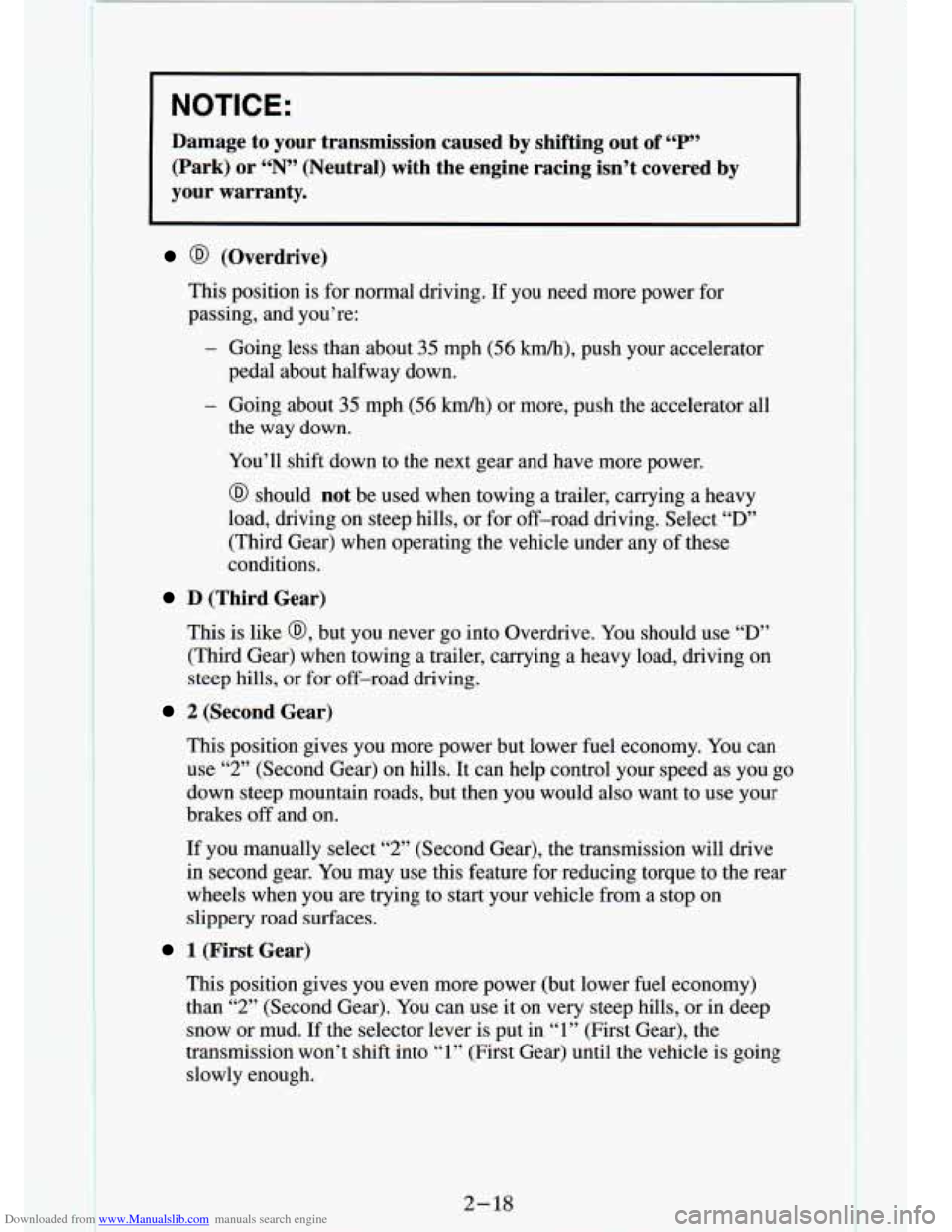
Downloaded from www.Manualslib.com manuals search engine NOTICE:
Damage to your transmission caused by shifting out of “P”
(Park) or “N” (Neutral) with the engine racing isn’t covered by
your warranty.
@ (Overdrive)
This position is for normal driving. If you need more p . rer f_ r
passing, and you’re:
- Going less than about 35 mph (56 ludh), push your accelerator
- Going about 35 mph (56 km/h) or more, push the accelerator all
pedal about halfway down.
the
way down.
You’ll shift down to the next gear and have more power.
@ should not be used when towing a trailer, carrying a heavy
load, driving on steep hills, or for off-road driving. Select
“D”
(Third Gear) when operating the vehicle under any of these
conditions.
D (Third Gear)
This is like @, but you never go into Overdrive. You should use “D”
(Third Gear) when towing a trailer, carrying a heavy load, driving on
steep hills, or for off-road driving.
2 (Second Gear)
This position gives you more power but lower fuel economy. You can
use
“2” (Second Gear) on hills. It can help control your speed as y\
ou go
down steep mountain roads, but then you would also want to use your
brakes
off and on.
If you manually select “2” (Second Gear), the transmission will drive
in second gear. You may use this feature for reducing torque to the rear
wheels when you are trying to start your vehicle from a stop on
slippery road surfaces.
1 (First Gear)
This position gives you even more power (but lower fuel economy)
than
“2” (Second Gear). You can use it on very steep hills, or in deep
snow or mud. If the selector lever is put in
“1” (First Gear), the
transmission won’t shift into
“1” (First Gear) until the vehicle is going
slowly enough.
2- 18
Page 65 of 340
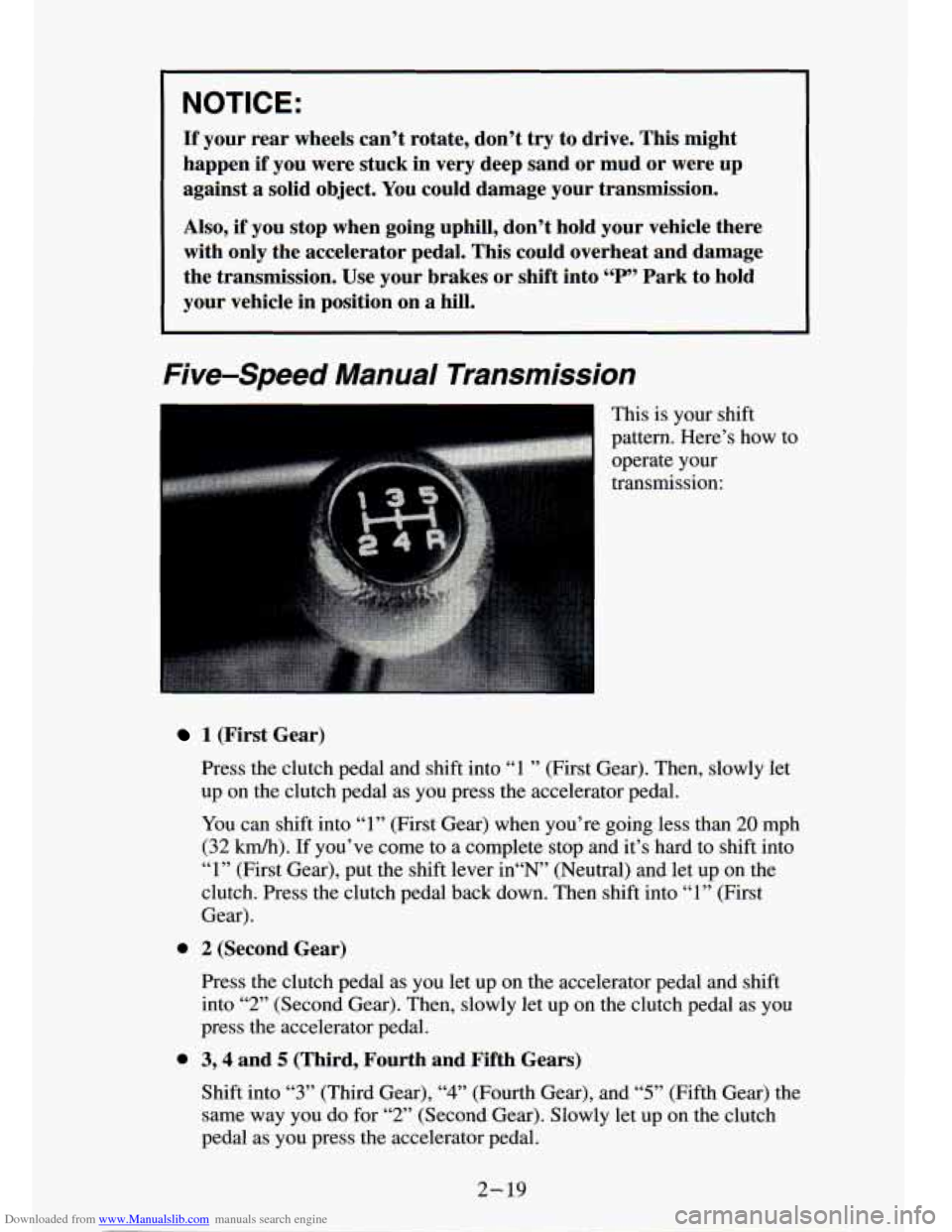
Downloaded from www.Manualslib.com manuals search engine NOTICE:
If your rear wheels can’t rotate, don’t try to drive. This might
happen
if you were stuck in very deep sand or mud or were up
against a solid object. You could damage your transmission.
Also,
if you stop when going uphill, don’t hold your vehicle there
with only the accelerator pedal. This could overheat and damage
the transmission. Use your brakes or shift into
“P” Park to hold
your vehicle in position on
a hill.
Five-Speed Manual Transmission
This is your shift
pattern. Here’s how to
operate your
transmission:
1 (First Gear)
Press the clutch pedal and shift into
“1 ” (First Gear). Then, slowly let
up on the clutch pedal as you press the accelerator pedal.
You can shift into
“1” (First Gear) when you’re going less than 20 mph
(32 km/h). If you’ve come to a complete stop and it’s hard to shift into
“1” (First Gear), put the shift lever in“N” (Neut\
ral) and let up
on the
clutch. Press the clutch pedal back down. Then shift into
“1” (First
Gear).
0 2 (Second Gear)
Press the clutch pedal as you let up
on the accelerator pedal and shift
into
“2” (Second Gear). Then, slowly let up on the clutch pedal as y\
ou
press the accelerator pedal.
0 3’4 and 5 (Third, Fourth and Fifth Gears)
Shift into
“3” (Third Gear), “4” (Fourth Gear), and “5” (Fifth Gear) the
same way
you do for “2” (Second Gear). Slowly let up on the clutch
pedal as
you press the accelerator pedal.
2-19